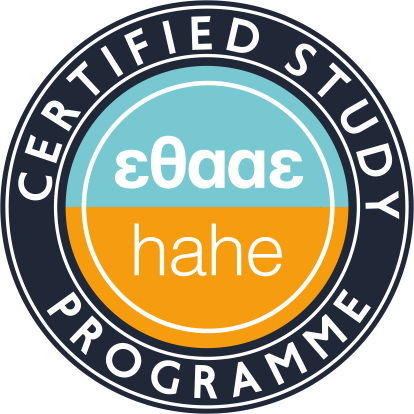

 , Chalkou Maria
, Chalkou Maria , Zannos Ioannis
, Zannos Ioannis
While discussing central texts in the field of media archaeology this module aims to function as an ongoing research studio with a critical perspective on the appraisal of transhumanism. Focusing on the inclusive discourse (queer, feminist, black, indigenous, disability, etc.) in intersection with coding, maker and hacker cultures, this module explores theoretical, methodological, and archival strategies for research on early or obsolete media artefacts as well as speculative fiction for alternative (im)probable futures.
Upon the successful completion of the course the students should be able to:
1. Critically analyse central texts in media archaeology, transhumanism, and related discourses, demonstrating a nuanced understanding of their theoretical underpinnings.
2. Understand and apply key theoretical frameworks in media archaeology, posthumanism, and inclusive discourses, to analyse media technologies and cultural contexts.
3. Methodologically approach and research early, outdated media, and explore alternative, potential, or near-future scenarios, while demonstrating competence in archival research and critical documentation.
4. Engage in inclusive discourse, incorporating perspectives from queer, feminist, postcolonial studies, and other marginalised viewpoints, and apply these lenses to media archaeology and technological narratives.
5. Develop research projects employing theoretical, methodological, and archival strategies learned in the course, as well as demonstrate originality and critical thinking through outputs such as proposals and presentations.
6. Synthesise diverse perspectives from media archaeology, posthumanism, and inclusive discourses, applying this synthesis to analyse and envision alternative media futures.
7. Engage in critical discussions, presentations, and peer reviews, articulating their understanding of media archaeology theories, methodologies, and their implications in contemporary media landscapes.
8. Demonstrate the ability to adapt theoretical frameworks and methodological approaches to evolving media landscapes, encouraging speculative and non-future scenario thinking.
The course includes the following topics:
1. Introduction to Media Archaeology: core concepts.
2. Archaeologies of Knowledge (preludio): canonical frameworks.
3. Methodological Approaches I: archive research to obsolete media.
4. Methodological Approaches II: experimental media to plausible futures.
5. Intermedia landscapes I: intersectional discourse.
6. Intermedia landscapes II: transhumanist discourse.
7. Intermedia landscapes III: hacking discourse.
8. Intermedia landscapes IV: queering discourse.
9. Archaeologies of Knowledge (intermezzo): Critical approaches to human–machine media archaeologies.
10. Media Aesthetics I: fictive imaginaries
11. Media Aesthetics II: object-oriented ontology
12. Media Aesthetics III: new materialism
13-14. Worldbuilding: alternative media archaeology project presentation, discussion and findings.
- Suggested bibliography:
Ahmed, S. (2006). Queer Phenomenology: Orientations, Objects, Others. Duke UP.
Baudrillard, J. (1994). Simulacra and Simulation. University of Michigan Press.
Bhabha, H. K. (2012) The Location of Culture. Routledge.
Bolter, J. D., & Grusin, R. (1999). Remediation: Understanding New Media. MIT Press (MA).
Braidotti, R. (2013). The Posthuman. John Wiley and Sons.
Dunne, A., & Raby, F. (2013). Speculative Everything: Design, Fiction, and Social Dreaming. MIT Press.
Ellul, J. (2021) The Technological Society. Vintage.
Foucault, M. (2012)l. The Archaeology of Knowledge. Vintage.
Gardiner, E., & Musto, R, G. (2015). The Digital Humanities: A Primer for Students and Scholars.
Cambridge UP.
Huhtamo, E., & Parikka, J. (2011). Media Archaeology: Approaches, Applications, and Implications. Univ of California Press.
Jameson, F. (2020). Archaeologies of the Future: The Desire Called Utopia and Other Science Fictions. Verso Books.
Manovich, L. (2002) The Language of New Media. MIT Press.
McLuhan, M. (2003). Understanding Media: The Extensions of Man. Corte Madera, CA : Gingko Press.
Mohanty, C. T. (2003). Feminism Without Borders: Decolonizing Theory, Practicing Solidarity. Duke UP.
More, M., & Vita-More, N. (2013). The Transhumanist Reader: Classical and Contemporary Essays on the Science, Technology, and Philosophy of the Human Future. John Wiley and Sons.
Parikka, J. (2013). What Is Media Archaeology? John Wiley and Sons.
Ritchin, F. (2010) After Photography. W W Norton and Company Incorporated.
Tsing, A. L. (2021). The Mushroom at the End of the World: On the Possibility of Life in Capitalist Ruins. Princeton UP.
- Related academic journals:
The Moving Image: The Journal of the Association of Moving Image Archivists / Science Fiction Studies / Representations / Leonardo
Distance learning
Use of ICT in teaching, laboratory education, communication with students.
Art interpretation: 15%
Public presentation: 15%
Research paper: 30%
Case study report: 15 %
Oral examination: 15 %
In-class participation and discussions: 10 %